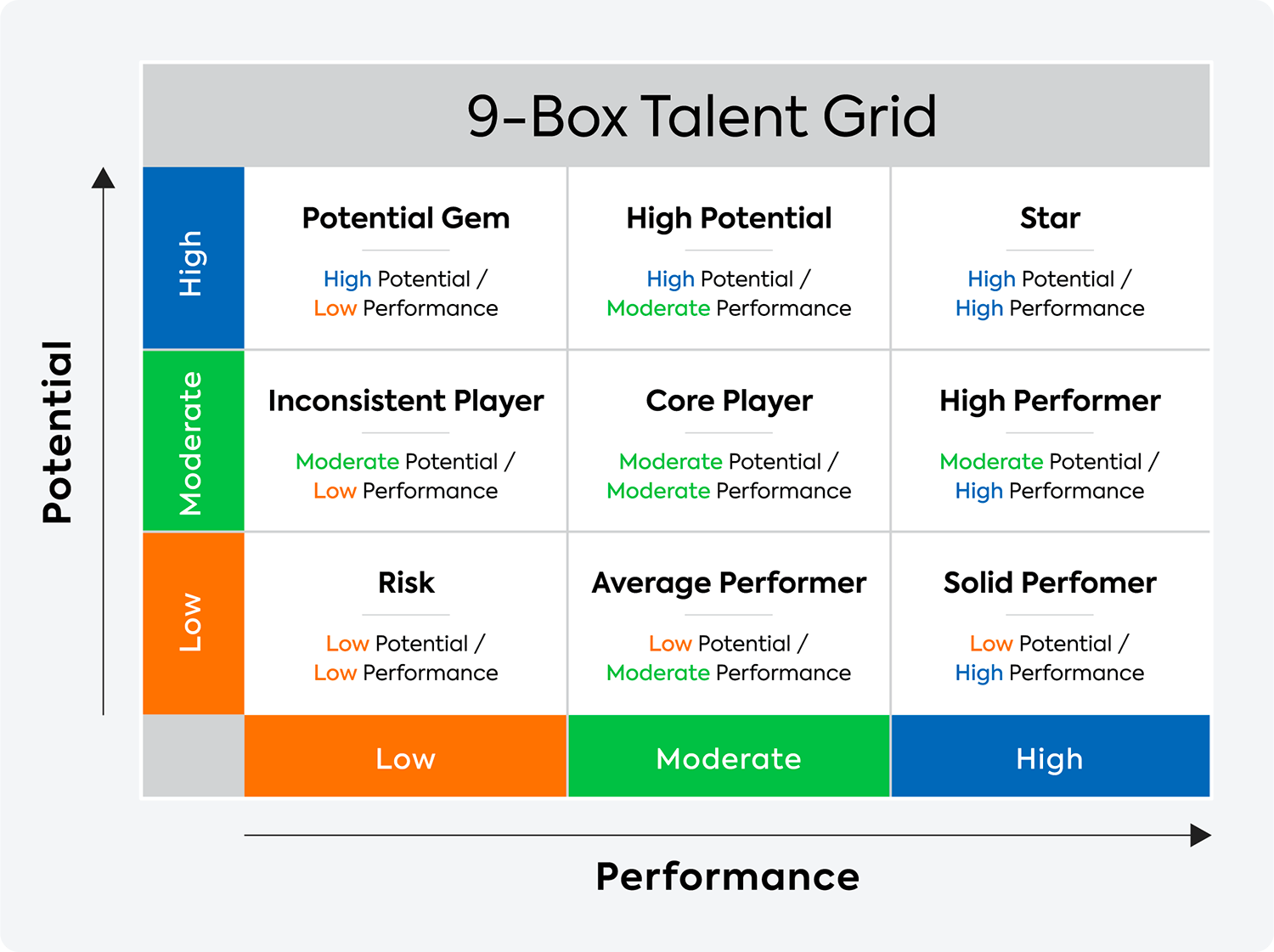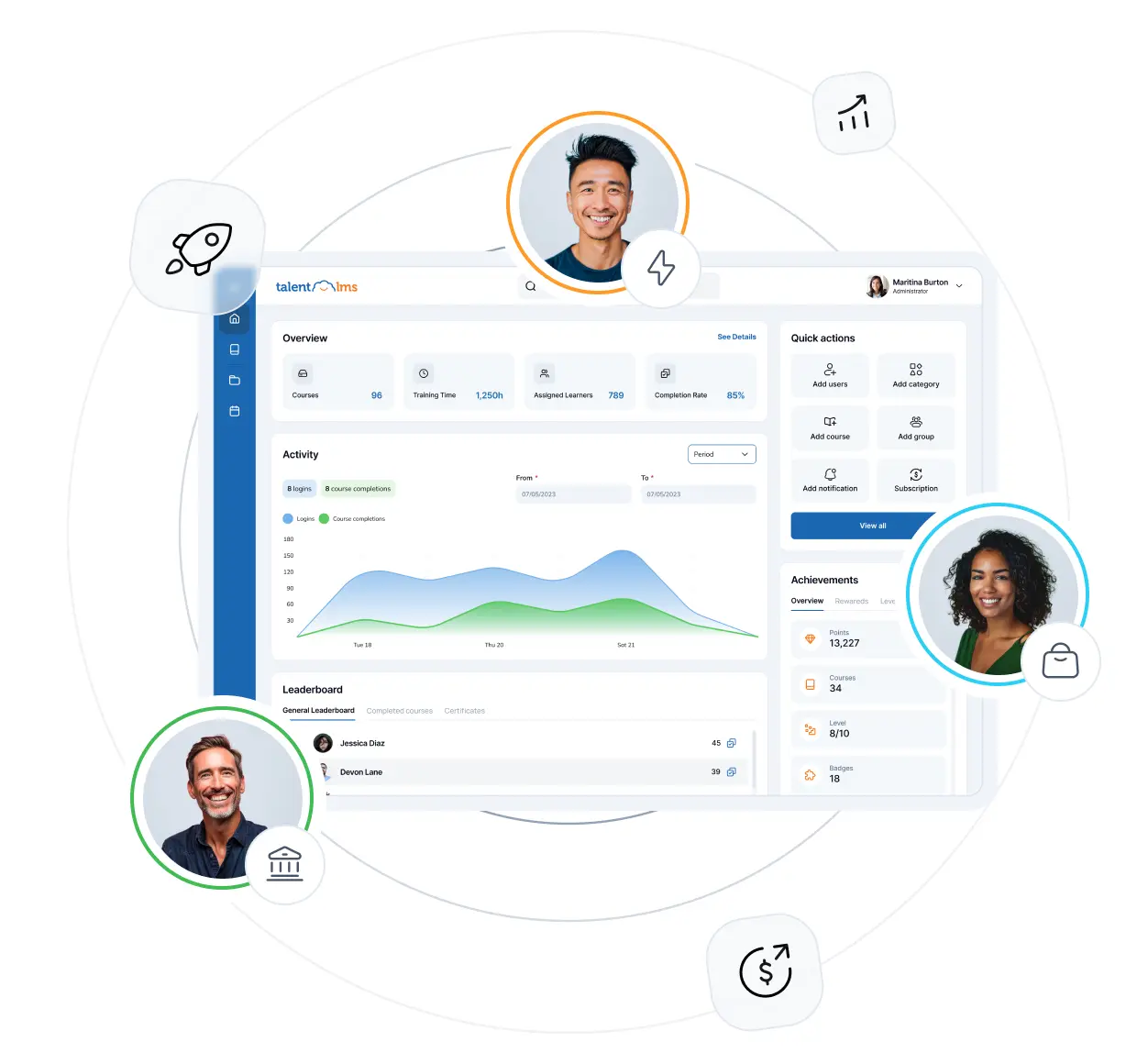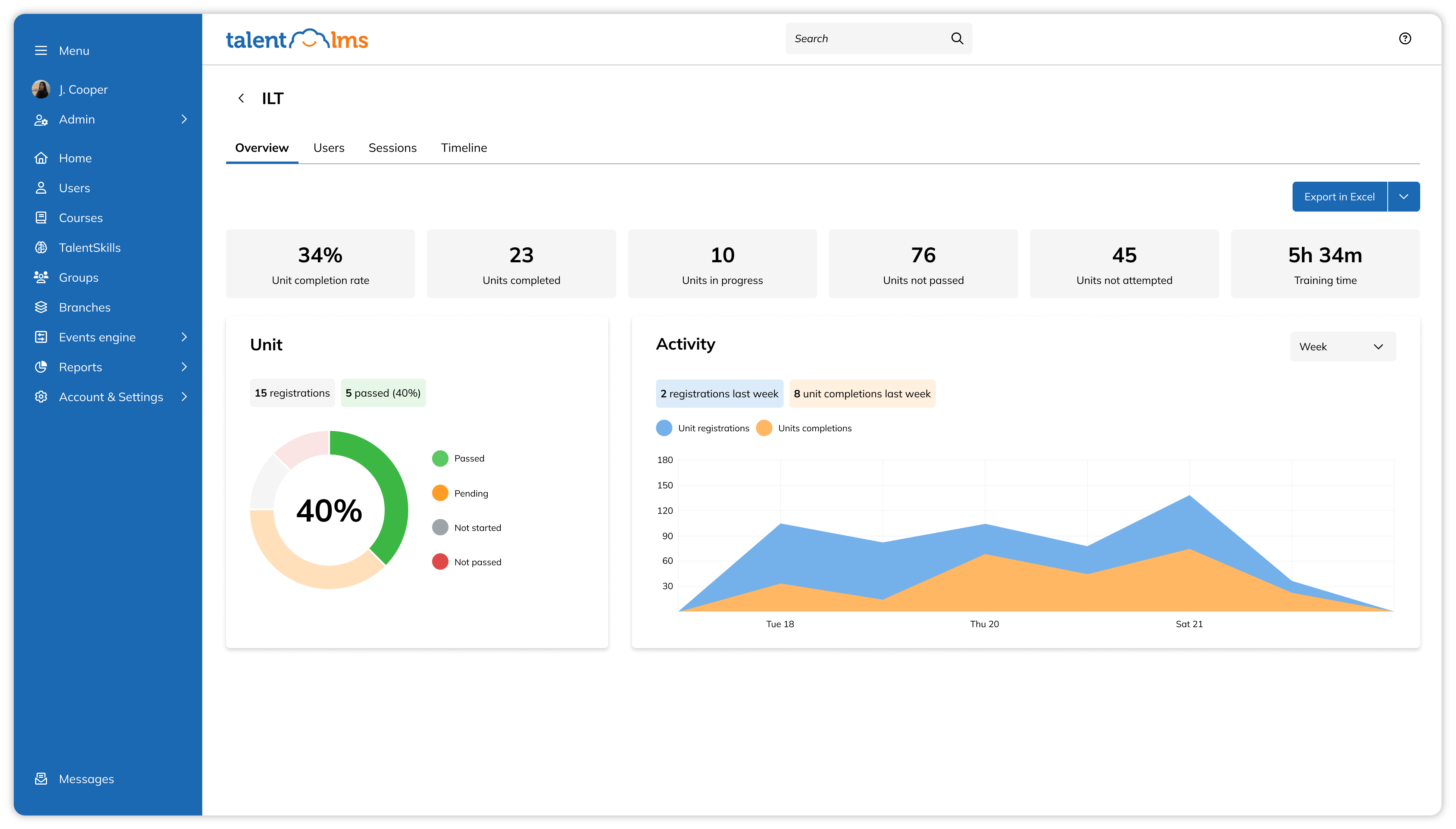Employee performance metrics aren’t just benchmarks for performance reviews and promotion considerations. When you measure employee performance effectively, you can also improve employee well-being, productivity, and retention. All of which are key drivers for business growth and success.
But it’s not always easy to know how to evaluate employee performance or which performance metrics to track.
This article provides a detailed list of the 26 most powerful employee performance metrics and shares why they’re so influential. To see how you can evaluate employee performance, get your own performance evaluation template below.
What are employee performance metrics?
Employee performance metrics are measurements that show how successful employees are in their jobs. They also demonstrate how this personal success relates to overall business health.
Often known as key performance indicators (KPIs) or objectives and key results (OKRs), they cover quantifiable measures like productivity, employee performance metrics, quality, and efficiency. However, employee performance metrics also include performance indicators that can’t be boiled down to numbers. Strong team communication, for example, can impact your results as much as the number of deals closed weekly.
Set, monitored, and evaluated mostly by L&D teams and managers, employee performance metrics are multifaceted.
For businesses, employee performance metrics:
- Measure productivity, efficiency, and contribution to company goals
- Identify high-performing talent for promotions and recognition
- Inform data-driven decisions for resource allocation and workforce planning
- Support a culture of value and appreciation
- Identify skills gaps and areas for focused training
- Align employee efforts with broader organizational objectives.
For individual employees, employee performance metrics:
- Provide clear expectations and goals for performance
- Support personal and professional development and continuous learning
- Identify areas of strength and opportunities for improvement
- Promote engagement and motivation
- Encourage accountability.
Did you know?
According to research, 82% of managers say they have “limited to no” ability to hold others accountable successfully. And 91% of employees would say that “effectively holding others accountable” is one of their company’s top leadership development needs.
26 key employee performance metrics
Below, we explore the most critical employee performance metrics in four main categories: work quality, work quantity, work efficiency, and organizational-level metrics. Not all of these metrics will apply to all of your employees or all business types, industries, or models. But they provide a comprehensive catalog of employee performance metrics you can pick and choose from to suit your company’s unique needs.
Work quantity metrics
Work quantity metrics refer to the amount of work produced by an employee. Focused on outcomes and processes, they apply to productivity and can be directly measured in numbers. For instance, “how many units are produced per hour” or “how many sales calls are completed in a week.” Because of this, they are the easiest employee performance metrics to measure and are likely the first that comes to mind when you think about employee performance. Specific work quantity employee performance metrics vary according to industry and role. The following list covers some of the more general measures alongside some of the most common, business-specific models and metrics.
1. Task completion rate
What: Registers the number of tasks or projects an employee completes within a given timeframe. This metric is relevant across all industries and roles, especially in project-based or deadline-driven environments.
Why: Provides an insight into an employee’s productivity and time management, both of which impact a company’s bottom line.
2. Errors made
What: Tracks the number of mistakes or inaccuracies in an employee’s work, such as product defects, coding errors, or documentation issues.
Why: Indicates whether further training is needed or processes need improvement.
3. Units produced
What: This output-centered metric is often used in manufacturing and data entry roles. It involves tracking the number of products, inputs, tasks, services, or units produced within a specific timeframe.
Why: Helps assess how effectively an employee contributes to output and meets production targets.
4. Number of sales
What: The simplest way to assess sales employees is to record the number of sales made in a certain period of time. In more complex sales environments, other metrics, such as the number of client contacts or calls, are more indicative of long-term success.
Why: Directly reflects an employee’s ability to generate revenue, meet targets, and contribute to a business’s financial success.
5. Handling time and resolution rates
What: In service industries, metrics like handling time (the average duration of customer interactions) and first-call resolution rates measure efficiency and productivity.
Why: Shows how well an employee contributes to customer satisfaction and operational performance.

6. Number of calls/emails handled
What: Most relevant to customer service and support roles, this metric logs the volume of customer interactions an employee manages in a certain period
Why: Provides insight into an employee’s productivity, availability, and responsiveness, which are key to maintaining client satisfaction.
7. Customer issue resolution
What: Commonly applied to customer service, technical support, and helpdesk roles, this metric is presented as a percentage. It’s achieved by dividing the number of customer issues logged by the total number of customer issues resolved. This figure is then multiplied by 100.
Why: Critical to customer satisfaction, this highlights an employee’s effectiveness in solving issues promptly and efficiently.
8. Conversion rate
What: Tracks the percentage of leads or prospects that are successfully turned into customers. This metric is most relevant to sales and marketing roles in industries focused on customer acquisition and revenue generation. To determine the percentage, divide the total number of leads that become paying customers by the total number of leads, then multiply by 100.
Why: Mirrors the effectiveness of an employee’s efforts in driving overall sales performance and revenue growth.
The numbers from this quantitative approach indicate work getting done, so they’re important employee performance metrics to track. But they don’t tell the whole story. You can’t rely solely on this metric as an indicator of success.
Time to add ‘quality’ metrics into the mix.
Work quality metrics
Work quality metrics assess the standard or excellence of an employee’s work compared to others. They also show how they align with organizational goals and values. The quality of an employee’s work may seem like an abstract idea. But it can have a direct impact on customer satisfaction and team productivity. And there are both subjective and objective ways to measure employee performance metrics in this area.
9. Management by Objectives (MBO)
What: MBO structures performance appraisals by setting specific goals between managers and employees, allowing progress to be tracked and evaluated.
Why: Aligns individual performance with organizational objectives. Provides clear benchmarks for success, which drives the quality of output, accountability, and focused effort.
10. Manager appraisals
What: Regular performance management reviews, typically twice a year, allow managers to assess an employee’s work quality based on several criteria. To obtain a high-level view of individual performance compared to minimum standards, apply an average performance review rating. This is where total performance review scores are divided by the total number of performance reviews across the same period. The 9-box grid is another method that can be used to provide a measurement associated with appraisals. Based on a 3×3 table, an employee is assessed on performance and potential and is a helpful tool for succession management.

Why: Offers valuable insights into an employee’s strengths, areas for improvement, and overall contribution to team and organizational goals.
Pro tip:
An employee performance review template provides a standardized structure to appraisals to ensure a fair and consistent approach.
11. 360-degree and 180-degree feedback
What: These feedback systems involve gathering input from peers, managers, and sometimes customers. To source a specific metric, apply scores for different criteria and compare these to produce average ratings.
Why: Sourcing employee evaluation comments and feedback compiles a balanced, well-rounded view of an employee’s performance in terms of quality. This is crucial for a fair and constructive employee performance evaluation.
Did you know?
Forty-six percent of employees found applying a 360 feedback policy helpful in eliminating toxic work culture, but only 41% of employees say their company supports a culture of constructive feedback.
12. Rate of return
What: Registers the number of products returned or complaints lodged according to an individual employee’s work or service.
Why: Can be an indicator of quality of work but may, equally, highlight issues in production or service delivery. For this reason, be careful when using this metric on its own to measure the quality of an individual employee’s output.
13. Net promoter score (NPS)
What: NPS reflects the likelihood of clients recommending a company’s services.
Why: Typically a sales measure, NPS can indicate the quality of an individual employee’s customer interactions and overall level of service.
By combining quality with quantity employee performance metrics, we’re starting to get a more rounded picture of an employee’s overall performance. But it’s not the whole picture. Achieving a balance between work quantity and quality is critical for sustaining high performance. Which is where efficient metrics come into play.
Work efficiency metrics
Work efficiency measures the ratio of input to output. It combines quantity and quality by measuring how well resources (for example, time and money) are used to achieve outputs. For example, a programmer may produce a high code volume, but the quality must be assessed to ensure it meets standards. An employee’s efficiency and effectiveness are often evidence of their problem-solving or innovation skills. Someone who gets their work done correctly and on time shows they know how to tackle problems or optimize processes.
14. Task completion time
What: Measures how long it takes an employee to meet deadlines and finalize specific tasks while maintaining work standards.
Why: Offers insights into an employee’s time management and productivity capabilities.
15. Cost per task
What: Evaluates the financial cost associated with completing a specific task (for example, salaries, wages, benefits, material, overhead, tools, and software) divided by the number of tasks completed.
Why: Helps to optimize resource allocation.
16. Absenteeism rate
What: Average number of days an employee was absent (minus approved absences) in a defined timeframe.
Why: Provides context around dips in employee productivity. Frequent absences can indicate disengagement or personal challenges, affecting both individual performance and overall efficiency. Can also suggest underlying general problems with workload distribution, work environment, or employee morale.
17. Overtime per employee
What: The time an employee works above their standard contracted number of days/hours within a certain timeframe.
Why: Occasional overtime may indicate dedication. However, consistent overtime suggests inefficiencies or overwork, which can lead to burnout and reduced productivity. It can also indicate an operating model that can damage a business’s bottom line.
Pro tip
This metric needs to be evaluated over a longer time frame (for example, 6-12 months) to determine a consistent pattern rather than a one-off spike.
18. Task prioritization
What: The ability to organize and complete tasks based on urgency and importance.
Why: Ensures employees manage time and resources effectively to contribute to overall productivity.
Did you know?
Tools such as performance reviews, task management systems, and project tracking software can provide insights into how effectively employees meet deadlines and prioritize tasks in relation to overall goals. Feedback from managers or peers is also valuable when assessing this metric.
19. Revenue per employee
What: This metric calculates the average revenue generated per person within a specific time frame.
Why: Helps to gauge the overall productivity and efficiency of an employee. It can also help you pinpoint specific areas that need improvement.
These efficiency numbers can help leaders know how to help individual employees progress. But they also indicate areas within a company’s overall business model that might need further investigation. Which leads us to the next type of employee performance metrics—organizational-level metrics.
Organizational metrics
Organizational-level employee performance metrics gauge a company’s overall efficiency and competitiveness by evaluating the collective performance of the workforce.
Research shows that more than 9 in 10 employers believe that driving organizational performance is a key objective for performance management. A report by McKinsey supports this value. Sixty percent of respondents who consider their companies’ performance-management systems effective say their companies have outperformed their peers in the past three years. The following employee performance metrics speak for themselves regarding their impact on organizational performance. All of them are linked to overall performance, workforce effectiveness, growth trajectory, and general financial health. they include:
20. Profit Per Employee (FTE)
Another metric to consider is how much profit each employee creates for the company.
Here’s how to calculate it: Profit Per Employee (FTE) = Net Profit / Total Full-Time Equivalent (FTE) Employees
Where:
- “Net Profit” = Revenue – Expenses
- FTE Employees = Number of full-time employees + (Part-time employee hours / Full-time hours)
21. Human Capital ROI
This metric assesses the return on investment for human capital.
Here’s how to calculate it: Human Capital ROI = (Revenue – Operating Expenses (excluding employee costs)) / Total Employee Costs
Where:
- Revenue = Total income generated
- Operating Expenses (excluding employee costs) = All operational costs except salaries, benefits, and training
- Total Employee Costs = Salaries, benefits, training, and other employee-related expenses
22. Employee Retention Rate (ERR)
This metric calculates the percentage of employees who stayed with the company over a given period.
Here’s how to calculate it: ERR = ((Total Employees at End of Period – New Hires During Period) / Total Employees at Start of Period) × 100
Where:
- Total Employees at End of Period = Number of employees remaining at the end of the period
- New Hires During Period = Employees who joined within the period
- Total Employees at Start of Period = Employees at the beginning of the period
23. Time since last promotion
This metric tracks the average time since an employee’s last promotion.
Here’s how to calculate it: Time Since Last Promotion = Current Date – Date of Last Promotion
This can be measured in days, months, or years depending on reporting needs.
Employee engagement metrics
Employee engagement plays a vital role in performance, influencing productivity, retention, and overall morale. It can be a hard employee performance metric to measure as it encompasses general factors such as participation, enthusiasm, and a willingness to get things done. But the following metrics provide a good level of insight:
24. Engagement scores
What: Use surveys and feedback mechanisms to assess employee commitment and enthusiasm for their work and the organization.
Why: High engagement is directly linked to overall organizational success. Data from this metric can be used to pinpoint areas for improvement, which benefits both employees and employers.
Did you know?
The openness and measurability associated with employee performance metrics also support a fair and consistent approach to employee performance management and evaluation. Which, in turn, underpins engagement. This is especially important when you consider that only 1 in 3 employees feel their performance is evaluated fairly.
25. Teamwork and collaboration
What: Broken down, this employee performance metric centers on evaluating levels of communication, cooperation, and conflict resolution. Gather feedback on a scale by running pulse surveys asking employees how they or others step up to help their team. Add to this by asking leaders to track how often employees volunteer to help out with things not formally assigned to them.
Why: Teamwork metrics help you see where your strongest team players are. They also give you a sense of which employees could use coaching to improve the overall team dynamic.
26. Learning and development participation
What: L&D success can be partly measured by things like completion rates and quiz scores and by comparing knowledge ratings from before and after training. These metrics can be easily sourced through good employee training software platforms. However, you should also gauge whether the skills and knowledge from training are being applied back to the job. This can be done through 360 surveys where managers and colleagues can provide feedback about how performance has changed.
Why: Tracking employees’ engagement in training programs shows their commitment to growth and improving performance. It indicates a growth mindset that reflects positively on a business’s learning culture. This employee performance metric can also highlight potential skills gaps and key areas for development or recruitment.
Did you know?
More than one in two companies faces a skills gap, and half are addressing it by training existing employees. To measure a skills gap in their companies, HR managers rely on performance reviews (46%), feedback from managers (36%), and skills gap analysis (34%).
To track the effectiveness and efficiency of your online training using KPIs, check out the Ultimate KPI Cheat Sheet for Corporate Learning below.
The benefits of measuring employee performance
Employee performance metrics empower businesses to make data-backed decisions, align their teams with strategic goals, and create an environment where employees thrive. They lead to higher levels of employee engagement, satisfaction, and trust and support more informed decision-making. All of this, in turn, builds stronger teams, increases productivity, and leads to better business outcomes. But to reap these benefits, you need to have the right balance.
No single metric captures all aspects of employee performance. The most effective performance evaluation uses a range of metrics to produce a clear and complete view rather than just a quick, unfocused snapshot.
Useful resources:
- How to Build a Performance Evaluation System (+ Template)
- Performance Review Templates + Examples for You & Your Team
- 160+ Actionable Employee Evaluation Comments & Phrases
FAQs: Employee performance metrics
1. How do you measure employee performance?
There are a number of ways to measure employee performance. On a very basic level you should follow these three steps:
- Set role-specific goals with measurable employee metrics or KPIs
- Create training opportunities for employee development
- Evaluate performance based on the set employee metrics or KPIs
2. What is the 5 point scale for employee evaluation?
Some companies use a rating scale to evaluate employee performance. One of the most common is the 5-point rating scale (1 – Below expectations, 2 – Needs improvement, 3 – Meets expectations, 4 – Exceeds expectations, 5 – Exceptional Performance). For more info, check out this performance review template.
3. What are performance metrics and examples?
Examples of employee performance metrics include: Quantity, quality, efficiency, effectiveness, abseenteeism, overtime, attendance, Net Promoter Score (NPS), revenue per employee, human capital ROI and more. These key performance indicators for employees are a great way to measure and evaluate performance.
Originally published on: 13 Sep 2022 | Tags: Employee Engagement,learning and development,training and development






